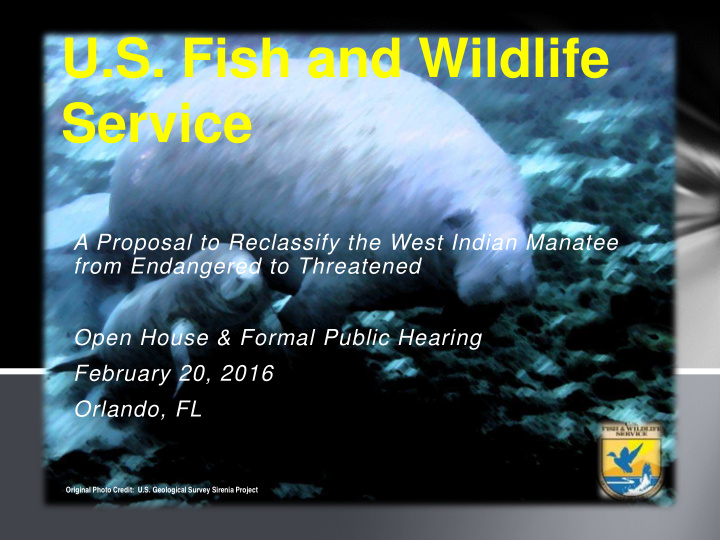



U.S. Fish and Wildlife Service A Proposal to Reclassify the West Indian Manatee from Endangered to Threatened Open House & Formal Public Hearing February 20, 2016 Orlando, FL Original Photo Credit: U.S. Geological Survey Sirenia Project
List of Endangered and Threatened Wildlife (from 50 CFR 17.11, January 29, 2016) Vertebrate Species population Historic Critical where Status When listed Special rules Range habitat endangered Common Scientific or threatened name name Mammals U.S.A. (southeastern Manatee, 1967 Trichechus Designated 1 Adopted 2 Entire Endangered ), Caribbean West Indian manatus* 1970 Sea, South America *Includes both subspecies, the Florida ( Trichechus manatus latirostris ) manatee and the Antillean manatee ( Trichechu 1 Critical habitat was designated in 1976. See 50 CFR 17.95(a) for description. 2 Manatee refuges and santuaries have been designated. See 50 CFR Subpart J 17 for descriptions.
United States 600 ~ Mes 0 300 I Range 1 1111 Tr/chechus manatus H/111111 Onan Map: U.S. Fish and Wildlife Service, J. Cooke
Status Definitions An “ Endangered Species” is a species which is in danger of extinction throughout all or a significant portion of its range. A species that is in danger of extinction is one that is currently on the brink of extinction in the wild. A “Threatened Species” is any species which is likely to become an endangered species within the foreseeable future throughout all or a significant portion of its range. Not on the brink of extinction but threats remain and must be addressed for full recovery.
ESA T HREATS E VALUATION (A) The present or threatened destruction, modification, or curtailment of its habitat or range; (B) Overutilization for commercial, recreational, scientific, or educational purposes; (C) Disease or predation; (D) The inadequacy of existing regulatory mechanisms; (E) Other natural or manmade factors affecting its continued existence.
Habitat Fishing gear fragmentation entanglements Photo Credit: U.S. Geological Survey Sirenia Project Original Photo Credit: FL Fish and Wildlife Comm. Original Photo Credit: U.S.F.W.S. J Valade Watercraft Loss of warm collisions water habitat Original Photo Credit: U.S. Geological Survey Sirenia Project Original Image Credit: Florida Powr and Light Co.
Original Photo Credit: U.S. Army Corps of Engineers Original Photo Credit: U.S. Fish and Wildlife Service, J Valade Original Photo Credit: Crystal River NWR, J Kleen
The West Indian manatee population exceeds 13,000 manatees and includes about 6,350 manatees in the southeastern United States and 532 manatees in Puerto Rico. Original Photo Credit: Innovative Health Associates
Models describe an Antillean population with positive growth and a Florida population with a less than 2.5% possibility that that population will fall below 4,000 individuals over the next 100 years. Original Photo Credit: Crystal River NWR, K Ramos
Based on our analysis and review of current information, the Service believes the West Indian manatee no longer fits the definition of endangered and as such proposes to change the species’ status to threatened. Original Photo Credit: U.S. Geological Survey Sirenia Project
What changes now or if status is changed? Simply put, regardless of status on the list of threatened and endangered species…nothing! ALL federal manatee protection and conservation measures remain unchanged, and additional measures can be added if warranted. ALL manatee protection areas (speeds zones and sanctuaries) remain enforced and compliance mandatory. Project consultation processes remain unchanged. Manatee conservation efforts will continue into the foreseeable future.
Public Open Comment Period January 8, 2016 through April 7, 2016 All comments and information received, including those received at tonight’s formal hearing, are reviewed and consider by Service staff in making their final decision.
You may submit information by one of the following methods: (1) Electronically: Go to the Federal eRulemaking Portal: http://www.regulations.gov/. In the Keyword box, enter Docket Number FWS-R4-ES-2015-0178. Then, in the Search panel on the left side of the screen under the Document Type heading, click on the Proposed Rules link. You may submit a comment by clicking on “Send a Comment or Submission.” (2) U.S. mail or hand-delivery: Public Comments Processing, Attn: Docket No. FWS-R4-ES-2015-0178, U.S. Fish and Wildlife Headquarters, MS: BPHC, 5275 Leesburg Pike, Falls Church, VA 22041-3803 S UBMISSIONS MUST BE RECEIVED ON OR BEFORE A PRIL 7, 2016.
Recommend
More recommend